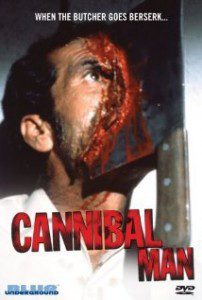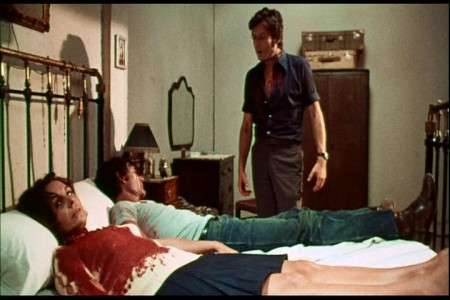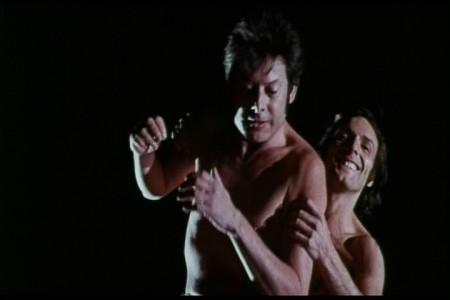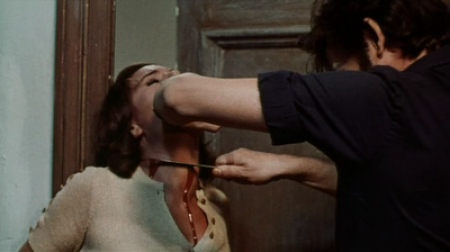Cannibal Man, La Semana del Asesino (1973)
Directed by: Eloy de la Iglesia
Written by: Antonio Fos, Dick Randall, Eloy de la Iglesia
Starring: Emma Cohen, Eusebio Poncela, Vicente Parra
Cannibal Man (AKA La Semana del Asesino) (1973)
First released: 1981
Director: Eloy de la Iglesia
Current UK status: Passed as an 18 certificate with 3 seconds of cuts, available uncut on region 1
Cannibal Man was first released in the UK in 1981 by Intervision, and this version was uncut. There is not a lot of violence and gore on offer here, and so when the film was removed from shelves and added to the list in July 1983, it was probably more to do with the title of the film, not the content. As with most of the films I have covered so far, Cannibal Man became one of the collectable’s from the DPP (Director of Public Prosecutions) list. The cover came in a flimsy slip case, and so mint condition copies became very rare and worth a lot of money. Redemption eventually released the film in 1993 with 3 seconds of cuts, although if you are desperate for those 3 seconds you can get the uncut version on region 1.
Director Eloy de la Iglesia always wanted to make movies, from a young age he tried to get into Spain’s National Film School, however he was too young to attend. Instead, he decided to study philosophy and literature in Madrid, but gave up and moved into directing children’s theatre. This then led to children’s programmes for Radiotelevision Espanola in Barcelona, where Iglesia became well established. He made his first film at the age of 22 (Fantasy 3) in 1966, and then went on to do his mandatory military service, and it was during this time he wrote the script for his second film Algo Amargo en la Boca (Something Bitter Tasting) (1968). This, and his third film had problems with censorship and failed to reach an audience, and it was his fourth film, El Techo de Cristal (The Glass Ceiling) (1970), which gained critical acclaim and the attention he desired.
During the time when he made Cannibal Man, the early seventies, Iglesia was a member of the Spanish Communist Party, and used his films as a way of getting his point across, often using violent forms of social protest in his stories. Iglesia’s increasing intensity in his films got him into trouble not only with censors, but also with Francisco Franco’s regime, and in the early 80’s the director turned his attention to homosexuality and social issues. Focusing on delinquent teens and drug abuse, he himself became addicted to heroin, and after the film La Estanquera de vallecas (The Tobacconist from Vallecas) (1987), Iglesia stopped making films for 15 years. He later claimed his addiction to films was stronger than his addiction to heroin, and he returned to directing in 2003 with The Bulgarian Lovers. Sadly Iglesia died of cancer on March 24th 2006, age 62.
Cannibal Man is a strange one indeed, firstly there is absolutely no cannibalism in the film whatsoever (well, apart from an accidental scene later on if you are going to be picky), and for me, it was hard to tell whether this film was being played serious, or for laughs. Now, if this was intended to be a bit of a comedy, then at times it is genius, however if the plan was to make a serious drama, then at times things go horribly wrong. The plot centres around a funny old chap named Marcus (a brilliant Vincente Parra), he works in an abattoir and has a steady girlfriend and lives with his brother. His life is about to be turned upside down when he gets into an argument with a taxi driver who doesn’t take too kindly to Marcus, and his extremely sexy girlfriend having a bit of a kissing session in the back of his cab. “Haven’t you ever been with a girl before??” Bellows Marcus as the taxi driver kicks them out: “what are you, a homosexual??!” This leads to the taxi driver getting angry, demanding pay for the short journey and finally kneeing poor old Marcus between the legs. The taxi driver is excessive as he now turns on Marcus’ girlfriend, and rightly so Marcus defends her. Wrongly though, he chooses to smash the driver over the head with a rock. They run off, but later find out the taxi driver died, and this leads Marcus into a downward spiral of paranoia and cover ups. The hilarious thing about it all is that, unfortunately, he brings it all on himself as the film progresses.
We get the feeling he is a bit odd as he likes to sit on his living room, half naked and frantically starring at pictures of models in bikini’s on his wall. Iglesia’s expert camera work of close ups and sudden zooming shots really emphasise things not quite right in Marcus’ head. A stroke of genius for its time, but sadly this sort of camera work would not really get much attention nowadays. Me, I really admired the chaotic camera all throughout the film, and feel Iglesia has not had enough credit for just how wonderfully he creates scenes of madness, or just simple scenes of bizarre reflection. Hell, he even makes sex look unsettling as we watch Marcus and his girlfriend get down to it, with close ups, above shots, zooming shots, images of sweat, an almost slow motion style and the sound of a clock, it looks far from enjoyable!
However, as the couple begin to worry about being found out for the murder of the taxi driver, Marcus decides it is time to cover his tracks. During yet another bizarre kissing scene, he decides to strangle his girlfriend, and leaves the body in his bedroom to rot. The downward spiral begins to intensify as Marcus ends up in situations where the only way out is to kill. See, if people stopped visiting, or stopped wanting to help clean his bedroom, he wouldn’t need to kill them. Sadly, with his brother returning home, his Father-in-law visiting, the waitress bringing him “pastries”, Marcus is left with no choice as the nosey buggers keep wanting to see his bedroom. The bodies pile up, the smell gets worse, and he is left to take the bodies to the abattoir to hide the evidence.
The film cleverly plays out with the camera never leaving Marcus, except for some brief moments where we join his homosexual neighbour in the high rise apartment block. The equally strange man can look right into Marcus’ run down living room, and he enjoys watching the less wealthy people live their lives. A social observation from Iglesia at how the rich look down upon the poor, and also it makes out that the rich are bored and fed up, while those poverty stricken have friends and make the best out of what they have. A final shot of high rise rich building with Marcus’ almost slums like area is testament to the fact Iglesia wanted to make a point.
Marcus befriends the homosexual “spy” and in one of the weirdest scenes in the film, the pair go swimming at night and laugh and joke as they splash around and through a beachball at each other while odd music plays. We see the stressed out Marcus have fun and smile, for the first time in the film. He has left his worries of dead bodies piling up and stench at home, he is free, momentarily. The scene is strangely hypnotic and oddly uplifting as you do your best not to laugh out loud. Moments like this show off Iglesia’s skills, and bravery. As for the violence, there is very little and apart from a shocking opening scene in the abattoir showing cows get slaughtered, there is very little here which would have upset viewers back then, and will certainly not even raise an eyebrow these days. The kills mostly happen off screen, and we get to see the final bit, like a glorious shot of a man with a meat clever wedged in his face (the shot which would make the films video and DVD artwork) or the woman who has her throat cut. It is all pretty tame, but good fun to watch. As long as you go into Cannibal Man not looking for anything too serious or offensive then there is a lot to enjoy here. As I said earlier, if this is played for laughs then it is superb. A scene in the local cafe where Marcus is served meat soup, made from the meat from his factory, is hilarious as he realises he might be eating his dead girlfriend. To me, scenes like this are to make us laugh simply by the way in which it is presented to us.
Cannibal Man is fun, no doubt about it, and as with the majority of the Video Nasties, the dubbing is horrendous, but only heightens the enjoyment. All the cast give it their all, and there are no Oscar worthy performances here, but Marcus especially, allows you to almost side with him, you at least sympathise with him in a twisted sort of way. In fact, I almost felt sorry for the poor fella!
So, should Cannibal Man have been added to the Video Nasties List? Hell no, apart from the title, the cover and the abattoir scene, this is pretty tame and not very offensive. A silly decision by the DPP.









Be the first to comment